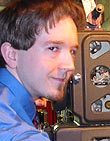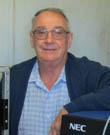|
|
This topic comprises 2 pages: 1 2
|
|
Author
|
Topic: Cutting aperture plates
|
|
|
|
|
|
|
|
|
|
|
Monte L Fullmer
Film God

Posts: 8367
From: Nampa, Idaho, USA
Registered: Nov 2004
|
 posted 03-05-2006 02:51 AM
posted 03-05-2006 02:51 AM




...another trick, if the overcut isn't too big, is to take the aperture plate, which is usually made of brass, place it on an anvil, or hard piece of flat steel.
Since the soundtrack side of the aperture opening is towards the outboard end of the plate, one can actually "move" the brass from the outboard of the opening toward the inside with light taps with a small round end punch and hammer.
Also, as one lightly hammers, the punch is positioned in an inward angle towards the center. By doing this, the punch is actually "pushing" the brass inwards to where there is enough "pushed" brass to do a refile on that one side.
Had to do this a few times on overcuts that I've noticed.
Saves on the extensive filing and purchases of a new aperture plate.
...Course, having a Dremel tool works wonders on cutting new plates as well with the right grinding bits - then just file for the fine and straight edge...lol.
EDIT: before you do begin to cut any aperture plate(s), make sure that the projector/console is level - both "X" and "Y" areas since a lot of units will settle over time.
After making sure that your units are level, then run a "RP-40" loop to ensure the machinery is level and center with the screen. How you do this is with the flat lens in the machine, the loop running and the aperture plate removed.
Then, before cutting apertures for the anamorphic lens, continue running the "RP-40" to ensure that the lens attachment(s) are centered with the projector after leveling the console/projector to square. And if the anamorphic attachments are in a turret setup, use the adjustments needed for centering that lens to the projector. Even with single lens machines, some machines do have a fine tuning to center lens with the machine.
And, if no fine tuning adjustments to center the lens with the machine, is to, once again have the "RP-40" loop running, flat lens, aperture removed and physically moved the base of the console/pedestal to center the machine to where the center line of the loop matches the center line of the screen. Then, once again check for the "X"/"Y" leveling of the unit after such a move has been taken.
-Monte
[ 03-05-2006, 11:50 PM: Message edited by: Monte L Fullmer ]
| IP: Logged
|
|
Will Kutler
Phenomenal Film Handler

Posts: 1506
From: Tucson, AZ, USA
Registered: Feb 2001
|
 posted 03-06-2006 02:05 AM
posted 03-06-2006 02:05 AM




We beat this topic to death long ago.
The type of file that is needed can be purchased through Grobet... the premier file manufacturer that can be found at any reliable lapidary supply store.
Look at their on-line catalog, but what you need is a non-tapered "safe" file meaning that the entire length of the file has no taper, and one or more edges have no teeth.
Grobet has a variety of safe file sizes, ranging anywhere from Swiss to larger files and with a full variety of tooth coarsness (mill, fine, bastard, etc, etc)
And since aperture plates are generally brass, here is a very old Tool and Die Maker's trick to prevent a file from being ruined from "clogging" due to brass being a soft metal: Loading the file with chalkboard chalk and cleaning it with a file card every few strokes as needed and then re-loading it.
Also, file safety...ALWAYS use a file handle and safety glasses! That brass leaves "fine" chips that can easily get transfered from your fingers to your eyes, if you happen to touch your eyes while filing! That fine filing chips can also damage projector and film if it is not carefully cleaned up!
Also, be sure to deburr aperture plates after filing. I know of one "tech" who failed to do so, and I became this idiot's victim. Anyhow, during one show, it appeared that some type of hair or bristle brush was cought in the aperture and was annoying on screen. Anyhow, it was not a hair of brush bristle, but a filing burr that cut me like a razor blade when I went to inspect it!
| IP: Logged
|
|
|
|
|
|
|
|
|
|
|
|
|
|
|
|
|
|
|
|
All times are Central (GMT -6:00)
|
This topic comprises 2 pages: 1 2
|
Powered by Infopop Corporation
UBB.classicTM
6.3.1.2
The Film-Tech Forums are designed for various members related to the cinema industry to express their opinions, viewpoints and testimonials on various products, services and events based upon speculation, personal knowledge and factual information through use, therefore all views represented here allow no liability upon the publishers of this web site and the owners of said views assume no liability for any ill will resulting from these postings. The posts made here are for educational as well as entertainment purposes and as such anyone viewing this portion of the website must accept these views as statements of the author of that opinion
and agrees to release the authors from any and all liability.
|

 Home
Home
 Products
Products
 Store
Store
 Forum
Forum
 Warehouse
Warehouse
 Contact Us
Contact Us




 Printer-friendly view of this topic
Printer-friendly view of this topic














![[Cool]](cool.gif)


![[thumbsup]](graemlins/thumbsup.gif)
![[Smile]](smile.gif)



